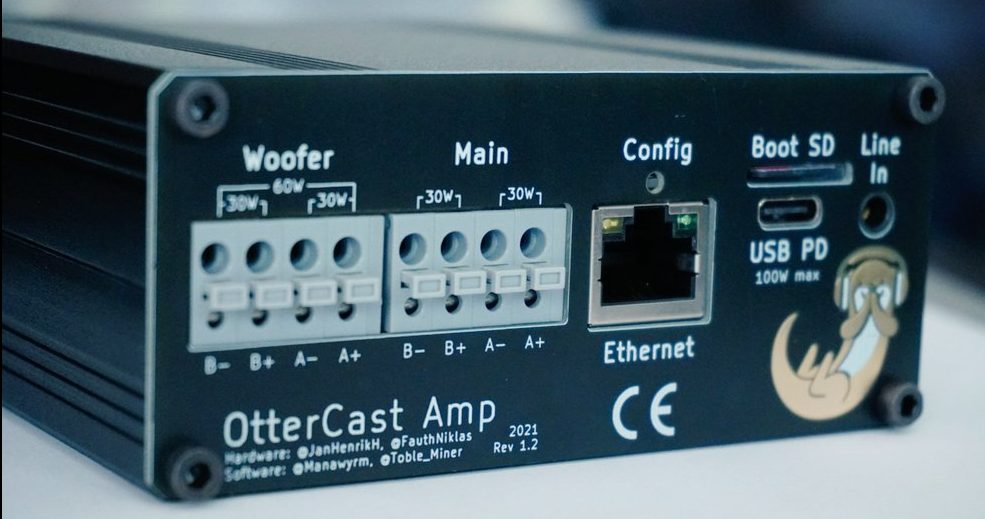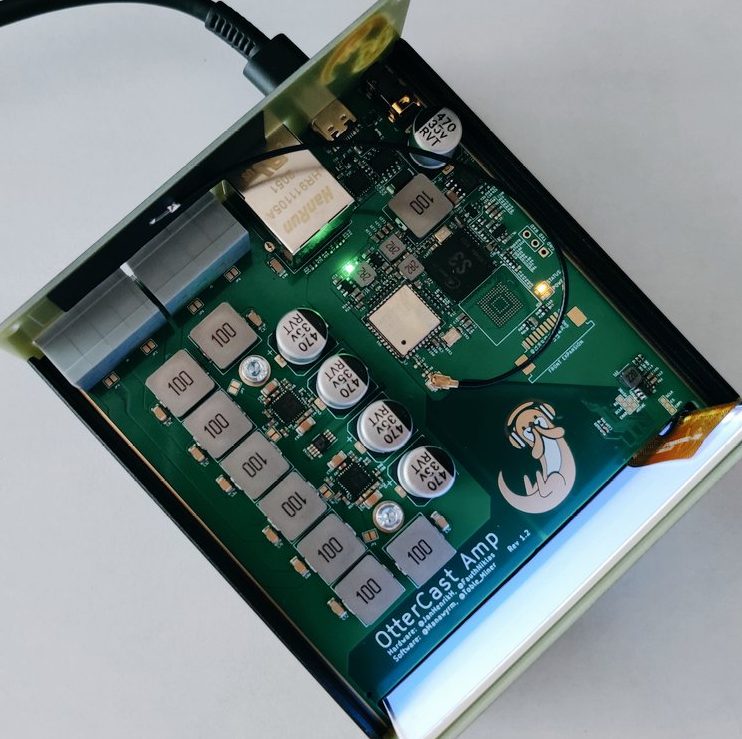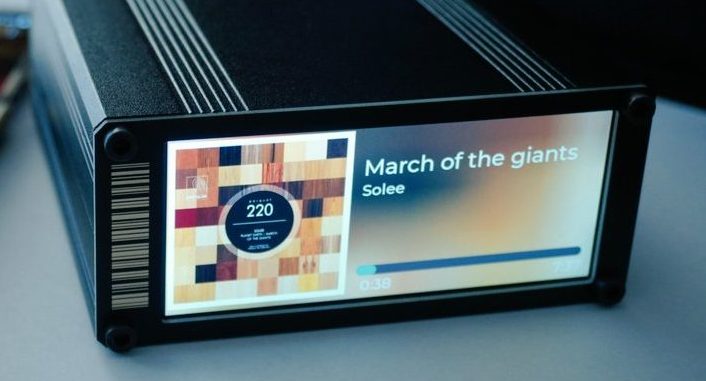Our favorite raft of otters is back at it again with another display of open source audio prowess as they bring us the OtterCastAmp, the newest member of the OtterCast family of open source audio multitools. If you looked at the previous entry in the series – the OtterCastAudio – and thought it was nice but lacking in the pixel count or output power departments then this is the device for you.
The Amp is fundamentally a very similar device to the OtterCastAudio. It shares the same Allwinner S3 Cortex-A application processor and runs the same embedded Linux build assembled with Buildroot. In turn it offers the same substantial set of features and audio protocol support. It can be targeted by Snapcast, Spotify Connect or AirPlay if those are your tools of choice, or act as a generic PulseAudio sink for your Linux audio needs. And there’s still a separate line in so it source audio as well.
 One look at the chassis and it’s clear that unlike the OtterCastAudio this is not a simple Chromecast Audio replacement. The face of the OtterCastAmp is graced by a luscious 340×800 LCD for all the cover art your listening ear can enjoy. And the raft of connectors in the back (and mountain of inductors on the PCBA) make it clear that this is a fully fledged class D amplifier, driving up to 120W of power across four channels. Though it may drive a theoretical 30W or 60W peak across its various outputs, with a maximum supply power of 100W (via USB-C power delivery, naturally) the true maximum output will be a little lower. Rounding out the feature set is an Ethernet jack and some wonderfully designed copper PCB otters to enjoy inside and out.
One look at the chassis and it’s clear that unlike the OtterCastAudio this is not a simple Chromecast Audio replacement. The face of the OtterCastAmp is graced by a luscious 340×800 LCD for all the cover art your listening ear can enjoy. And the raft of connectors in the back (and mountain of inductors on the PCBA) make it clear that this is a fully fledged class D amplifier, driving up to 120W of power across four channels. Though it may drive a theoretical 30W or 60W peak across its various outputs, with a maximum supply power of 100W (via USB-C power delivery, naturally) the true maximum output will be a little lower. Rounding out the feature set is an Ethernet jack and some wonderfully designed copper PCB otters to enjoy inside and out.
As before, it looks like this design is very close to ready for prime time but not quite there yet, so order at your own risk. Full fab files and some hints are linked in the repo mentioned above. If home fabrication is a little much it looks like there might be a small manufacturing run of these devices coming soon.
















I have only one / several problem(s) with this device: what’s it good for; what’s it do; why should I want one?
The developers have obviously given a lot of thought and put a lot of effort into designing a very nice piece of sophisticated hardware. Here’s where they, and a lot of extremely talented designers fall down on the job, and cause their efforts to fail–
they now need to devote as much time into designing a COMPELLING SALES DOCUMENT (OK, to be very crass about it–a compelling ‘sales brochure’. Not a dirty set of words, by any stretch of the imagination) which convinces US of the technical merits, features, and benefits of the device; and why we should want one. If need be, the help of an outside–expert–contractor which specializes in providing these services should be employed.
No device “sells itself”, no matter how good or novel. Most need all the help which can be given, or bought.
They’re only making a small production run, so I think the intent is for people to use the materials on github to make their own.
I think in that case, the device is not for you – They’re producing a very small run by the sounds of things, and releasing all the designs / software / PCB layouts for you to create (or evolve) your own… Sounds like the goal isn’t to sell many.
In that case, I think you’re right.
The logic of not providing the product’s operational details–in plain English–which would entice one to proceed any further is elusive, to say the least. It is NOT enough to say, “I have developed this really, REALLY neat device, and provided you with all the gory technical details needed to duplicate my efforts. That’s all you get. Now, have at it.”
The effort seems monumental AND highly professional,,,AND a tremendous amount of work to be wasted because of simply “…not tooting their own horn…”.
These guys make these things because of love for technology. Not for selling, not for fame. Just because they love their hobby.
While I find your point perfectly valid from an arbitrary consumer perspective, consider you’re writing your comment under an article that is effectively promotes it without conflicts of interest, and to an early adopter community that is already sold on the idea :)
I guess a sales brochure would start smelling fishy even for otters :D
Yes yes what this project needs is more marketing wank and less open source hardware crap for nerds. You got your finger on the pulse buddy.
I don’t know about a full blown brochure but I agree that the project looks really cool, I just don’t know exactly what it does. I am not into any kind of speaker hobby area so I don’t know what all the buzz/technical words mean.
Because it seems so polished and capable I am interested in it but couldn’t quite find a concise reason how my life would be improved for having this device in it.
Others have pointed out this is a hobby project for other like-minded hobbyists so there is absolutely no need for advertising as such. I just feel like I’m on the outside looking in and not really sure what’s going on.
It seems you connect this amp to speakers and can stream audio to it. I’m not familiar with the different protocols it lists. Does this device connect to the internet to stream the audio? Do you need to stream from the internet through an intermediate device (phone or computer) into this device? Does it require certain services to function (Spotify for instance) or does it simply take any audio stream from a device on the same network? Does it function like Sonos speakers where you can tune several of these to coexist in one room without interference – does Sonos even do that?
Sorry for the question dump, I’m not expecting all of them answered. This is an area I think I might enjoy getting into but so far don’t know anything about.
From the projects GitHub page, “OtterCastAmp is an open-source Sonos Amp replacement, based on a Sochip S3 SoC and pulseaudio sink/source.”
You are not a member of the target audience, if you don’t know what a Sonos Amp is, or you don’t care about what it does. I have two Sonos Amps, and I was considering another one for music in my office. The OtterCastAmp looks like a very nice upgrade over my exiting devices.
What is that 340×800 LCD they are using?
It’s in the github docs: https://github.com/Ottercast/OtterCastAmp/tree/main/datasheets
Why is there an ugly barcode on the front? Does it serve a purpose?
The Amazon app thinks it’s a barcode for hair colouring chalk.
I’m a little bit disappointed that it doesn’t lead in an Asterly direction.
https://github.com/Ottercast/OtterCastAmp/blob/main/front/barcode/barcode.png
… My barcode scanners couldn’t decode it normally, I had to enable “scan white barcode on black”. It says “OtterCast” in https://en.wikipedia.org/wiki/Code_128
Only change I’d make is adding a line-level output for the subwoofer, for people with a powered sub that has a line level input.
I’m wondering if the intended use is actually for bi-wired speakers ?
Also because it says woofer, not sub woofer I expect the cut off isn’t for sub frequencies.
Otherwise I would agree with you fully.
Can it run Doom?
Pretty sure it can, but I’m not sure it supports sound
Not sure if I’m alone in this, but for both this and the OtterCast “Chromecast replacement” (hard to call it that since it doesn’t actually tie into the Chromecast ecosystem) it would be awesome to have the opportunity to buy some kind of kit — with all the parts and hardware included, maybe a bit of simple soldering (not SMD) and assembly to finish the job.